ASUS VG236H 23-inch 3D Display Review: 120Hz is the Future
by Brian Klug on August 7, 2010 2:48 AM ESTImpressions and Subjective Analysis
Packaging for the VG246H is definitely a step above the drab cardboard boxes all my other monitors have come in, but honestly it’s probably not going to be something you keep around. Still nicely done though.
Inside is lots of styrofoam - the 3D Vision Kit comes cleverly nested in a small recessed area off to the right and gets protected the same way as the display. Carefully placed inside is the display itself, the monitor base, a few accessories bags for cables, a manual and getting started guide, and the warranty.
Assembling the display is easy, but not quite as polished of an undertaking as the other stands I’ve used. You lay the display flat on a desk or table (which is a bit scary, since you could scuff or scratch the important bits you're going to be staring at), and then screw the base into the display arm using a supplied nut which folds down, letting the assembly rotate.
The part that’s scary is releasing the height adjustment lock, which is literally a pin jammed in the mechanism, preventing the spring loaded height-adjustment arm from extending. There’s an awesome diagram in the manual which pretty much says it all.
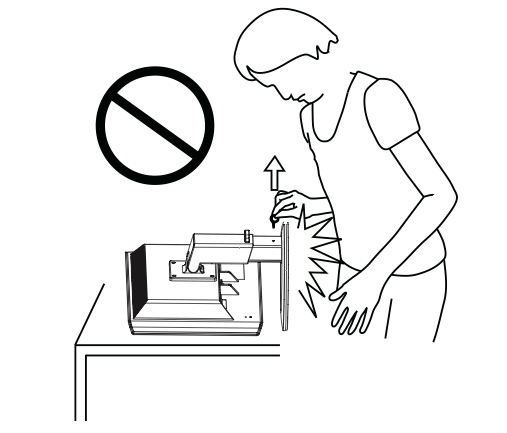
There’s also a yellow warning sticker right above where the pin is too. Thank goodness. Seriously, pull that pin out carefully, and only when you’re ready, or the monitor base will literally smash into your chest, or... other sensitive bits like that diagram above. Not fun.
Other display arms also usually have a height lock with a button of some kind, locking the display in its lowest height position. That makes it easy to transport the whole display assembly without having the base extended all the way and hitting your knees the whole time. Unfortunately, the VG236H lacks one of those - pick the display up, and the base will be sticking all the way out in its maximum extended position. Honestly, this is is the only truly major oversight on the entire display that I have some issue with.
The nice part about the display base however is that it swivels 150 degrees in each direction, which is awesome. The stand also tilts, and you get about 4 inches of height travel.
|
Tilt: -5 degrees to15 degrees
|
||
 |
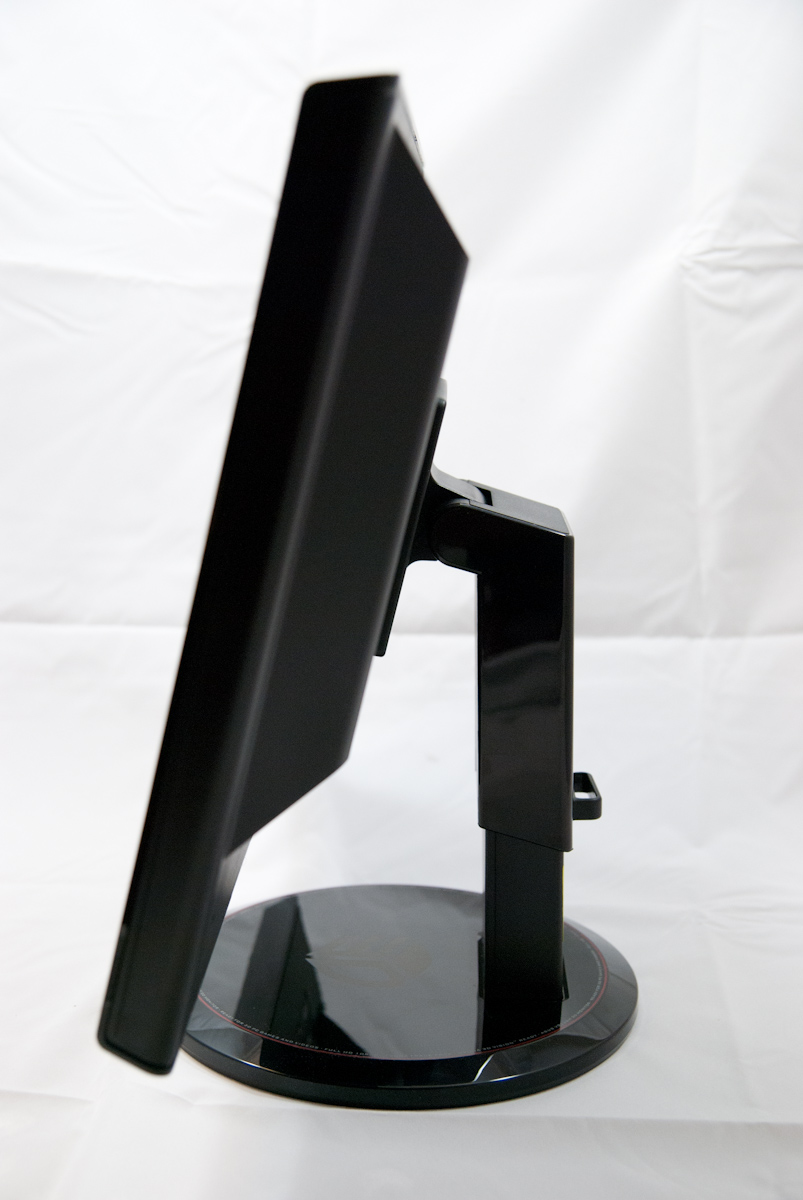 |
|
To be honest, the display arm feels a bit flimsy, but gets the job done just fine. The assembly is nicely balanced as well, not requiring much force to rotate, tilt, or adjust height. There’s no locking mechanisms for any of those three axes of adjustment, however.
|
Height Travel
|
||
 |
 |
|
Again, most of the monitor’s plastic bits that face you are glossy plastic, and do show fingerprints. Curiously enough, the back of the display is standard textured matte plastic. I’m left wondering why the whole thing couldn’t be this way. The base of the display is also glossy, as is a bit of the height adjustment arm.
There’s a cable guide on the back, if you use those.
Additionally, the display is VESA mount compatible (the arm it ships with is screwed in there), so you can roll your own stand if you choose like I usually do.


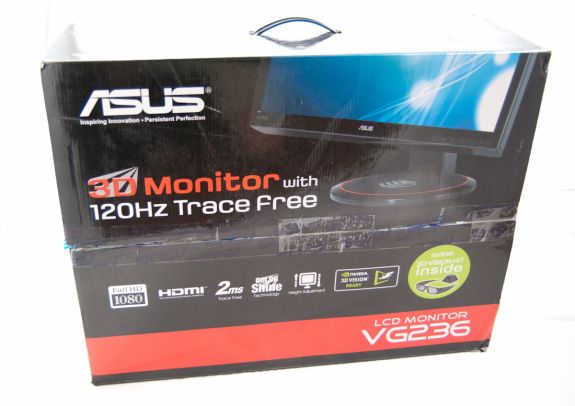
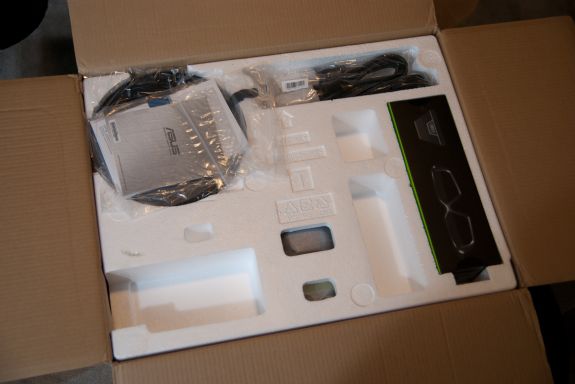
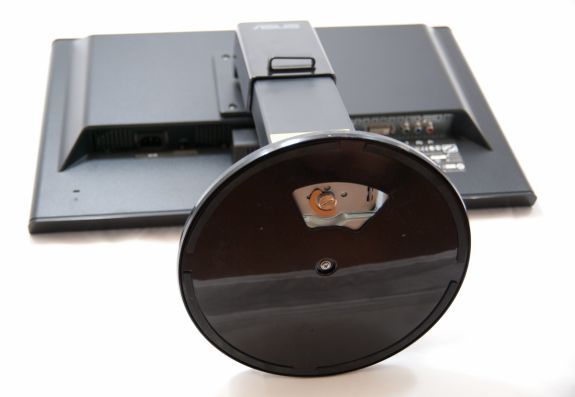
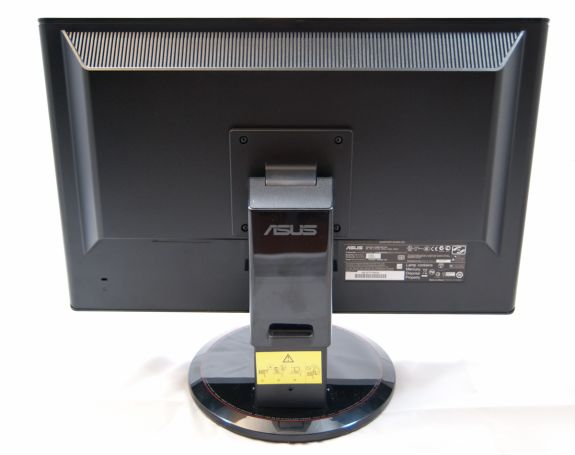








121 Comments
View All Comments
B3an - Sunday, August 8, 2010 - link
It's the less pixels and the simple fact that it's not good for a monitor. If you watch movies all day then its great. But for pretty much ANYTHING else it's inferior, even for something like reading this review as you have less vertical space and have to scroll more.I also don't like paying the same as a 16:10 monitor for less pixels.
It's getting harder to buy a quality LCD these days, you have shitty glossy screens, more and more ridiculously poor image quality TN panels, and now a inferior aspect ratio to top it off. Technology is meant to improve over time not go backwards.
Mr Perfect - Sunday, August 8, 2010 - link
Yes, the cut down pixels are a large part of my complaint. 16:9 is great for TVs since it fits the format of the content, but why deliberately cut down the vertical viewing space for a PC monitor? What could we possible gain from knocking it from 1920x1200 down to 1920x1080? It seems that the mainstream monitors are using 16:9 in the 24" space, while the higher quality models still offer 16:10. All 30" screens seem to be 16:10 yet, but who's got that kind of money?BTW, B3an, there are some newer 16:10 IPS screens kicking around. None of them are 120Hz though. :( TFTCentral has recently reviewed the HP ZR24W, NEC PA241W, Dell U2410, NEC LCD2490WUXi, NEC 24WMGX3 and HP LP2475W. They report that Hazro will soon be launching an updated line of 24" IPS screens as well, the HZ24W models a, b, and c.
seapeople - Sunday, August 8, 2010 - link
I disagree, I think 16:9 is a good aspect ratio. Yes, you have to scroll a bit more vertically, but you always have to scroll vertically anyway so why does it matter that much? On the other hand, the wider aspect ratio makes it easier to look at content side by side and/or prevent horizontal scrolling on wide content which is a pain.With that said, obviously 1900x1200 is better than 1900x1080 because it contains more pixels. However, I've found 1920x1080 monitors to be generally cheaper than the 1920x1200 equivalent. My 1920x1080 23" Dell monitor that I bought on sale for $160 18 months ago is an example.
DarkUltra - Sunday, August 8, 2010 - link
It really is a lot of display real estate you lose. It's not just a slim border at top and bottom. You can actually fit two Ribbon menus in the 120 vertical pixels, or two Windows 7 double-sized task bars. It's not about less width; there are bigger monitors. It's about having 3,7 cm extra height "for free" at same desk space.Old games like the 1600x1200 resolution better, and RTS games like Starcraft with a hud at the bottom is much better with 1920x1200.
AnnonymousCoward - Monday, August 9, 2010 - link
16:10 gives 23% more area with 4:3 pillarboxed content. That's huge.medi01 - Monday, August 9, 2010 - link
To create 4:3 X inches monitor, you need 12% more stuff. Is it clear?Stokestack - Sunday, August 8, 2010 - link
Glossy doesn't look better ANYWHERE. Even in a pitch-black closet, the image from the glossy screen still illuminates YOU, creating your reflection in the monitor. Therefore, those "deep blacks" and "rich colors" are neither; they're covered by a sheen of reflection in essentially all cases.It's a fraud that preys on consumer ignorance.
synaesthetic - Monday, August 9, 2010 - link
I miss my old 17" samsung LCD monitor. :(yeah, it was only 1280x1024 but... 5:4, not glossy and it... was pretty.
Stargrazer - Saturday, August 7, 2010 - link
"Further, instead of getting tearing above 60 FPS like you would with vsync off on a traditional 60Hz LCD, you get smoother gameplay that just looks more fluid. I definitely can tell the difference, and now I don’t want to go back."How much of a difference do you notice when vsync is *on*?
DarkUltra - Sunday, August 8, 2010 - link
Twice as much I would say. IF the objects move across the speed at 120 pixels per second, or you got a big jittery object that darts all around the screen. To make an impression the object needs enough "samples" across the temporal dimension to let the eye follow it.In other words, if you look around slowly in an FPS game, even 10FPS could be enough. If you flick your wrist fast, or enemies move fast, you can track them at up to 60 movements per second in 120fps/hz.